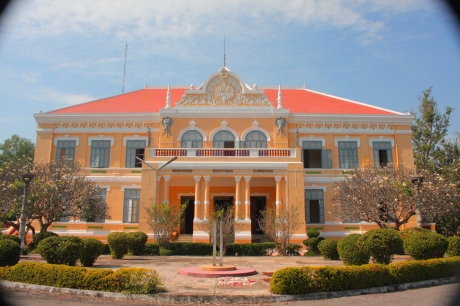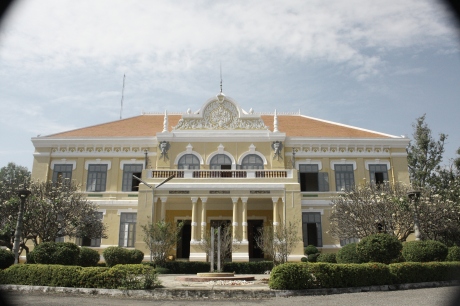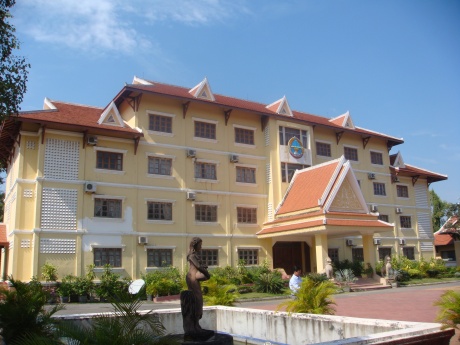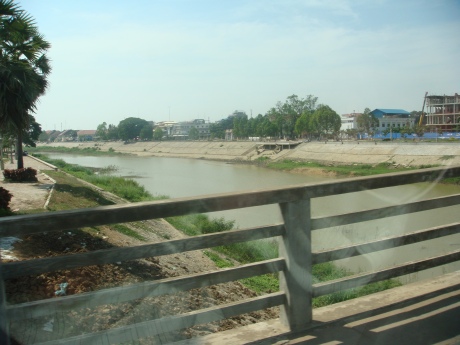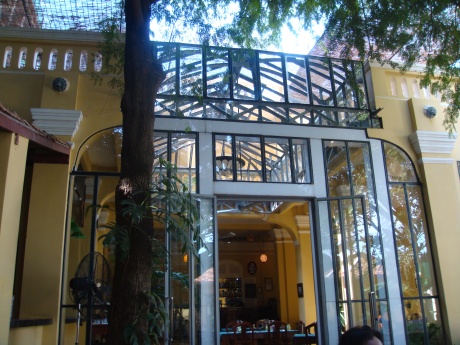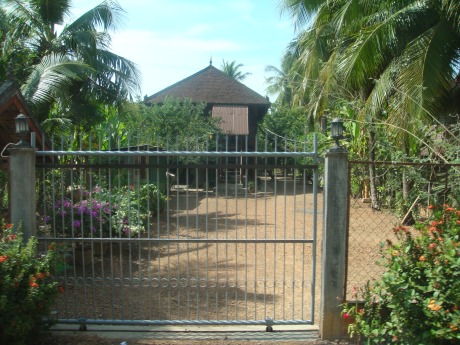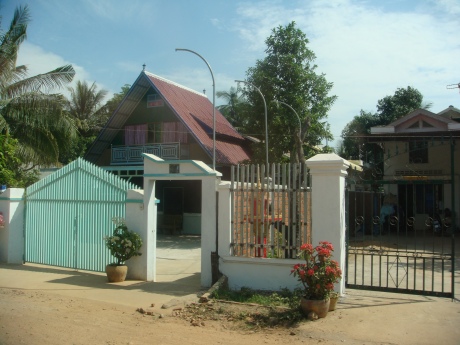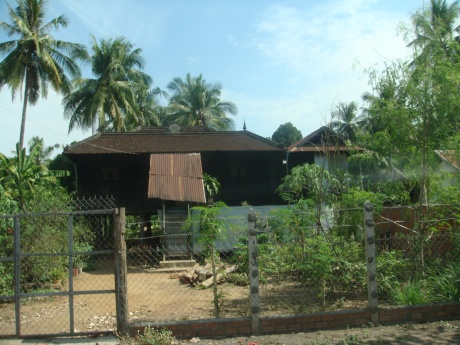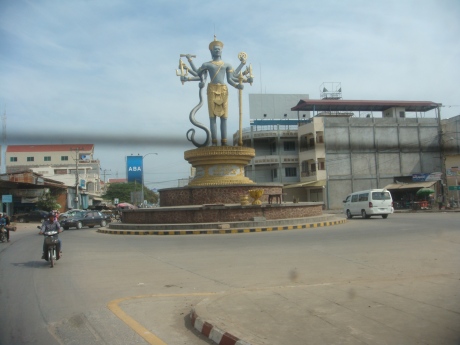Wednesday, January 26, 2011
Monday, November 29, 2010
Battambang
From Wikipedia, the free encyclopedia
Jump to: navigation, search
| City of Battambang ក្រុងបាត់ដំបង | |
|---|---|
| — City — | |
| Kranhoung Stick King | |
 City of Battambang | |
Coordinates:  13°06′N 103°12′E / 13.1°N 103.2°E / 13.1; 103.2 13°06′N 103°12′E / 13.1°N 103.2°E / 13.1; 103.2 | |
| Country | |
| Province | Battambang ខេត្តបាត់តំបង |
| Settled | 11th Century |
| Official | 1907 |
| Government | |
| - Type | City Municipality |
| Population (2009) | |
| - Total | 250,000 |
| [1] | |
| Time zone | Cambodia (UTC+7) |
| Website | City of Battambang |
Battambang is the second-largest city in Cambodia with a population of over 250,000. Founded in the 11th century by the Khmer Empire, Battambang is well known for being the leading rice-producing province of the country. For over 500 years, it was the main commercial hub of Siam's Eastern Provinces, though it was always populated by a mix of ethnic Thai, Lao, Chinese and Cambodians. Still today Battambang is the main hub of the Northwest connecting the entire region with Phnom Penh and Thailand, and as such it’s a vital link to Cambodia.
The city is situated by the Sangker River, a tranquil, small body of water that winds its way through Battambang Province providing its nice picturesque setting. As with much of Cambodia, the French Colonial architecture is an attractive bonus of the city. It is home to some of the best-preserved, French colonial architecture in the country.
Contents[hide] |
[edit] History
Ramayana depicted on carvings from the 11th century
The whole province was returned to Cambodia in 1907. Following from five times urban development of French colonial administration yielded the urban layout of Battambang enlarged the size of the French colonial town. In the first time development, they designed a grid pattern of well-defined streets, put in the urban structure and built roads such as Three main streets in town were built parallel to the Sangker River, connected the both side with two bridges in 1917. Military purposes and prison infrasture used erected inside the compound. Then, 19 years later ,a second urban development plan was created with a newly constructed railway linked Battambang to Phnom Penh. The urban structure was extended to the west of the town, featuring some important urban axes orienting on the railway station. Many outstanding buildings like residential villas and significant public buildings were constructed during that period. According to the third urban development plan for Battambang City, large extension areas were planned for the north, the east and for the south of the city. The both aesthetically and technically planned urban layout of that time was courageous and long-term thinking, featured some significant urban axis corresponding to the existing urban layout from the former period. Battambang city became the most developed part of all provincial even whole Cambodia, grew as a modern provincial capital, being the industrial and commercial centre of the region. Several large infrastructures and public facilities were built under the modernization program of the Cambodian government of then-prince Sihanouk. Several provincial departments, the court house and other public administrations were set up on both sides of the river. Textile and garment factories were built by French and Chinese investors, the airport was set running and the railway line was developed to reach Poipet. Numerous schools and a university were built. A sports centre, museum and an exhibition hall were constructed to serve the cultural needs of the growing population.
[edit] Attractions
Ba Set Templewas built during the reign of King, Soriyak Varman I (1002–1050) and located on a hill at Ba Set village, Ta Pun commune in 15-kilometre (9 mi) distance from the provincial town. Ba Set temple adapts the architecture of 11th century and built in 1036 and 1042. Next to the temple, there is a pond having 20-metre (66 ft) length 12-metre (39 ft) width and 10-metre (33 ft) depth. The pond is never dried, though in the dry season. In rainy season, the water level is higher than usual.
Wat Ek Temple
adapts the architecture of 11th century and built in 1027 during the reign of King, Sorayak Varman I (1002–1050). It is located at Piem Ek commune in 14-kilometre (9 mi) from the provincial town.
Ba Nan Temple
adapts the architecture of mid 11th century and the end of 12th century the temple was first built by King, Ut Tak Yea Tit Tya Varman II (1050–1066) and was built finally built by the king, Jayavarman VII (1181–1220). The temple is located on the top of approximate 400-metre (1,310 ft) heighten mountain at Koh Tey 2 commune, Ba Nan District in 15-kilometre (9 mi) distance from the provincial town by the provincial Road No 155 parallel to Sang Ke River. At the mountain’s valley, there are Ku Teuk and two main natural well, namely: Bit Meas and Chhung or Chhung Achey.
Prasat Snung
characterizes as three separated stupas made of brick, located on a hill having 30-metre (98 ft) length and 20-metre (66 ft) width, in Snung pagoda’s area, Snung commune, Ba Nan District in 22-kilometre (14 mi) distance from the provincial town. According to the style at the gate, the temple is similar to other temples in 12th century. Behind the temple, there is another new constructing temple.
Phnom Sam Pov Resort
is the natural resort located along the National Road No 57 (the former National Road No10) at Sam Puoy commune (the high land having more than 100-metre (330 ft) height) in 12-kilometre (7 mi) distance from the provincial town of Battambang. On the top of Sam Puoy mountain, there are temple and three natural wells, namely Pkar Slar, Lo Khuon and Ak So Pheak. Next to Sam Puoy mountain, there are some main mountains, the natural site like Phnom Trung Moan, Phnom Trung Tea and Phnom Neang Rum Say Sork. These mountains related to the Cambodia folk legend of Reach Kol Neang Rum Say Sork.
Boeng Kam Pinh Puoy Resort
locates between two mountains, named Phnom Kul or Phnom Ta Nget and Phnom Kam Pinh Puoy, at Ta Nget village, Ta Kriem Commune in 35-kilometre (22 mi) distance from the provincial town. Boeng kam Pinh Puoy has 1,900-metre (6,230 ft) width, 19-kilometre (12 mi) length and can load 110,000,000 cubic metres (3.8846×109 cu ft).
Sek Sak Resort
is the natural resort, which has been popular since before the civil war time. Sek Sak stretches along the river bank full of plant, trees and bamboo-green nature in 500-metre (1,640 ft) length. As long as visiting Sek Sak, tourists can also visit other attractive sites like Po Pus Pich Chen Da Dong Tong and Sa Ang speak, the pre-history site in five kilometer (3.1 mi) to six kilometer (3.75 mi) distance from each other. Sek Sak located Treng commune, Rotanak Mondul District in 50-kilometre (31 mi) distance from the provincial town of Battambang along the National Road No 57, the former National Road No 10.
Monday, November 15, 2010
battimbong provine
During the pre-Angkor and Angkor eras, the areas to the north and to the north west of the Tonle Sap Lake were known as the territories of Amogha Boreak and Bhima Boreak. During the Angkor period, the territory of Amogha Boreak was significantly prosperous because the land was so fertile that rice crops, fruit and vegetables produced excellent yields. Many Khmer people settled there as indicated by the existence of so many ancient temples in the area. With the exception of the temples of Wat Banan, Ek Phnom, Baseth, Stung, Banteay Tey, Banteay Chmar, etc.,other monuments, which were built by dignitaries and subjects at the time as places of worship to God and other deities of Buddhism and Hinduism, almost completely disappeared.
Between the 15th century and the 18th century the area was invaded by the Siamese army, forcing landowners off their land and splitting up their families.
From the late 18th century until early in the 20th century, the Siamese ruled Battambang and placed it under the rule of the Lord Chaofa Ben family, which was later known as the Akpheyyavong Family. This lasted for 6 generations and ended in 1907. While under Thai rule, the province was a changwat of Thailand called Phra Tabong.
The French Siamese Treaty of March 23, 1907, obliged the Siamese to return territories that they had occupied for more than a century. These included Battambang, Siem Reap and Angkor, in exchange for Trat province and the area of Dach Se (Lao territory) in the upper catchment area of the Mekong River. On December 6, 1907, His Majesty Preah Bat Sisowath issued a royal declaration splitting Battambang into 3 provinces: Battambang, Siem Reap and Serei Sophorn. In 1925, Battambang was divided again into two provinces: Battambang and Siem Reap, with Battambang having two districts: Battambang and Serei Sophorn. By 1940, Battambang consisted of 7 districts: Battambang, Sangke, Maung Russey, Monkol Borei, Toeuk Cho, Serei Sophorn, and Bei Thbaung.
In May 1953, the Poi Pet administration was founded and ordered under the district of Serei Sophorn which was divided into two districts: Serei Sophorn and Banteay Chmar. In March 1965, the administration of Poi Pet, was elevated to the status of a district named O Chrov. In July 1965, part of the territory of Maung Russey was separated to become the administration of Kors Kralor. In March 1966, another new district Thmar Pouk was founded and the district of Banteay Chmar was cut off from the province of Battambang for incorporation into Oddor Meanchey province, another newly founded province. In the early years of the Khmer Rouge, two new districts were established: Banan and Kors Lor. During the 3 years and 9 months of the Killing Fields, Battambang saw its people evacuated by Pol Pot's men from the city and towns and relocated to remote and mountainous areas. The province of Battambang, once known as the rice bowl of the country, was turned into a site of torture, killings, and starvation.
The province of Battambang was completely liberated from the genocidal regime on January 13, 1979. At that time, the People’s Committee of commune-Sangkat was founded through the first-ever elections in 1983. Between 1979 and 1986, Battambang had 9 districts and one provincial town.
In 1986, three new districts were created: Banan, Bovel, and Ek Phnom. Until that point, Battambang had 12 districts and 1 provincial town. In 1988, however 5 districts were separated and incorporated into the newly founded province of Banteay Meanchey.
In 1998, following the integration of the remaining territory of the former Democratic Kampuchea, the province of Battambang saw part of its territory separated for the municipality of Pailin, while 4 new districts were established: Samlot, Kamreang, Phnom Proeuk and Sampov Loun. In 2000, part of the district of Maung Russey was split off to become the district of Koas Krala.[
Between the 15th century and the 18th century the area was invaded by the Siamese army, forcing landowners off their land and splitting up their families.
From the late 18th century until early in the 20th century, the Siamese ruled Battambang and placed it under the rule of the Lord Chaofa Ben family, which was later known as the Akpheyyavong Family. This lasted for 6 generations and ended in 1907. While under Thai rule, the province was a changwat of Thailand called Phra Tabong.
The French Siamese Treaty of March 23, 1907, obliged the Siamese to return territories that they had occupied for more than a century. These included Battambang, Siem Reap and Angkor, in exchange for Trat province and the area of Dach Se (Lao territory) in the upper catchment area of the Mekong River. On December 6, 1907, His Majesty Preah Bat Sisowath issued a royal declaration splitting Battambang into 3 provinces: Battambang, Siem Reap and Serei Sophorn. In 1925, Battambang was divided again into two provinces: Battambang and Siem Reap, with Battambang having two districts: Battambang and Serei Sophorn. By 1940, Battambang consisted of 7 districts: Battambang, Sangke, Maung Russey, Monkol Borei, Toeuk Cho, Serei Sophorn, and Bei Thbaung.
In May 1953, the Poi Pet administration was founded and ordered under the district of Serei Sophorn which was divided into two districts: Serei Sophorn and Banteay Chmar. In March 1965, the administration of Poi Pet, was elevated to the status of a district named O Chrov. In July 1965, part of the territory of Maung Russey was separated to become the administration of Kors Kralor. In March 1966, another new district Thmar Pouk was founded and the district of Banteay Chmar was cut off from the province of Battambang for incorporation into Oddor Meanchey province, another newly founded province. In the early years of the Khmer Rouge, two new districts were established: Banan and Kors Lor. During the 3 years and 9 months of the Killing Fields, Battambang saw its people evacuated by Pol Pot's men from the city and towns and relocated to remote and mountainous areas. The province of Battambang, once known as the rice bowl of the country, was turned into a site of torture, killings, and starvation.
The province of Battambang was completely liberated from the genocidal regime on January 13, 1979. At that time, the People’s Committee of commune-Sangkat was founded through the first-ever elections in 1983. Between 1979 and 1986, Battambang had 9 districts and one provincial town.
In 1986, three new districts were created: Banan, Bovel, and Ek Phnom. Until that point, Battambang had 12 districts and 1 provincial town. In 1988, however 5 districts were separated and incorporated into the newly founded province of Banteay Meanchey.
In 1998, following the integration of the remaining territory of the former Democratic Kampuchea, the province of Battambang saw part of its territory separated for the municipality of Pailin, while 4 new districts were established: Samlot, Kamreang, Phnom Proeuk and Sampov Loun. In 2000, part of the district of Maung Russey was split off to become the district of Koas Krala.[
The province is an increasingly popular gateway to Cambodia from Hat Lek in eastern Thailand, in part due to the reasonably direct access to the port and beach resort town of Sihanoukville. The border is located at Cham Yeam, about 14km from Koh Kong.
Traveling to Koh Kong has become an enjoyable journey, where bridges were built, the first stage in 2002. A landmark of Koh Kong was made possible by L.Y.P. Group, the longest ever built bridge in Cambodia where you would want to experience the 1,900-meter crossing the sea connecting provincial town of Koh Kong to Koh Kong Resort and the international check point. In 2007 a new sealed road (National Route 48) was completed from the town to Sre Ambel on the Phnom Penh to Sihanoukville highway, including the 4 remaining river crossings where bridges were opened in May 2008 which are donations by the Thai government to Cambodia.
Traveling to Koh Kong has become an enjoyable journey, where bridges were built, the first stage in 2002. A landmark of Koh Kong was made possible by L.Y.P. Group, the longest ever built bridge in Cambodia where you would want to experience the 1,900-meter crossing the sea connecting provincial town of Koh Kong to Koh Kong Resort and the international check point. In 2007 a new sealed road (National Route 48) was completed from the town to Sre Ambel on the Phnom Penh to Sihanoukville highway, including the 4 remaining river crossings where bridges were opened in May 2008 which are donations by the Thai government to Cambodia.
Subscribe to:
Posts (Atom)




